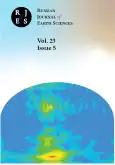MONITORING THE CONTENT OF POLYCYCLIC AROMATIC HYDROCARBONS IN SOILS AND NATURAL HERBAL VEGETATION OF TECHNOGENEOUSLY POLLUTED TERRITORY
- Authors: Barbashev A.1, Sushkova S.1, Dudnikova T.1, Minkina T.1, Popov V.1
-
Affiliations:
- Southern Federal University
- Issue: Vol 23, No 5 (2023)
- Pages: ES0209
- Section: Articles
- URL: https://journals.rcsi.science/1681-1208/article/view/259661
- DOI: https://doi.org/10.2205/2023ES02SI09
- ID: 259661
Cite item
Full Text
Keywords
About the authors
A. Barbashev
Southern Federal University
Email: rjes@gcras.ru
ORCID iD: 0000-0003-1857-948X
S. Sushkova
Southern Federal University
Email: rjes@gcras.ru
ORCID iD: 0000-0003-3470-9627
T. Dudnikova
Southern Federal University
Email: rjes@gcras.ru
ORCID iD: 0000-0002-8436-0198
T. Minkina
Southern Federal University
Email: rjes@gcras.ru
ORCID iD: 0000-0003-3022-0883
V. Popov
Southern Federal University
Author for correspondence.
Email: rjes@gcras.ru
ORCID iD: 0009-0002-2481-5346
References
- Abdel-Shafy, H. I., and M. S. M. Mansour (2016), A review on polycyclic aromatic hydrocarbons: Source, environmental impact, effect on human health and remediation, Egyptian Journal of Petroleum, 25(1), 107–123, https://doi.org/10.1016/j.ejpe.2015.03.011.
- Chai, C., Q. Cheng, J. Wu, L. Zeng, Q. Chen, X. Zhu, D. Ma, and W. Ge (2017), Contamination, source identification, and risk assessment of polycyclic aromatic hydrocarbons in the soils of vegetable greenhouses in Shandong, China, Ecotoxicology and Environmental Safety, 142, 181–188, https://doi.org/10.1016/j.ecoenv.2017.04.014.
- Cristale, J., F. S. Silva, G. J. Zocolo, and M. R. R. Marchi (2012), Influence of sugarcane burning on indoor/outdoor PAH air pollution in Brazil, Environmental Pollution, 169, 210–216, https://doi.org/10.1016/j.envpol.2012.03.045.
- GN 2.1.7.2041-06 (2006), Maximum Permissible Concentrations (MPC) and Estimated Permissible Concentrations (APC) of chemicals in soil: Hygienic standards (in Russian).
- GOST 17.4.3.01-2017 (2019), Nature protection. Soils. General requirement for sampling (in Russian).
- Kołtowski, M., I. Hilber, T. D. Bucheli, and P. Oleszczuk (2016), Effect of activated carbon and biochars on the bioavailability of polycyclic aromatic hydrocarbons in different industrially contaminated soils, Environmental Science and Pollution Research, 23(11), 11,058–11,068, https://doi.org/10.1007/s11356-016-6196-1.
- Kotoky, R., and P. Pandey (2018), Plant-microbe Symbiosis as an Instrument for the Mobilization and Removal of Heavy Metals from Contaminated Soils - A Realistic Approach, Current Biotechnology, 7(2), 71–79, https://doi.org/10.2174/2211550106666170321104354.
- Kumar, S. S., A. Kadier, S. K. Malyan, A. Ahmad, and N. R. Bishnoi (2017), Phytoremediation and Rhizoremediation: Uptake, Mobilization and Sequestration of Heavy Metals by Plants, in Plant-Microbe Interactions in Agro-Ecological Perspectives, pp. 367–394, Springer Singapore, https://doi.org/10.1007/978-981-10-6593-4_15.
- Kuppusamy, S., P. Thavamani, K. Venkateswarlu, Y. B. Lee, R. Naidu, and M. Megharaj (2017), Remediation approaches for polycyclic aromatic hydrocarbons (PAHs) contaminated soils: Technological constraints, emerging trends and future directions, Chemosphere, 168, 944–968, https://doi.org/10.1016/j.chemosphere.2016.10.115.
- Medunić, G., M. Ahel, I. B. Mihalić, V. G. Srček, N. Kopjar, Ž. Fiket, T. Bituh, and I. Mikac (2016), Toxic airborne S, PAH, and trace element legacy of the superhigh-organic-sulphur Raša coal combustion: Cytotoxicity and genotoxicity assessment of soil and ash, Science of The Total Environment, 566-567, 306–319, https://doi.org/10.1016/j.scitotenv.2016.05.096.
- Sasse, J., E. Martinoia, and T. Northen (2018), Feed Your Friends: Do Plant Exudates Shape the Root Microbiome?, Trends in Plant Science, 23(1), 25–41, https://doi.org/10.1016/j.tplants.2017.09.003.
- Sushkova, S. N., G. K. Vasilyeva, T. M. Minkina, S. S. Mandzhieva, I. G. Tjurina, S. I. Kolesnikov, R. Kizilkaya, and T. Askin (2014), New method for benzo[a]pyrene analysis in plant material using subcritical water extraction, Journal of Geochemical Exploration, 144, 267–272, https://doi.org/10.1016/j.gexplo.2014.02.018.
- Sushkova, S. N., T. M. Minkina, S. S. Mandzhieva, G. K. Vasilyeva, N. I. Borisenko, I. G. Turina, O. V. Bolotova, T. V. Varduni, and R. Kızılkaya (2015), New alternative method of benzo[a]pyrene extractionfrom soils and its approbation in soil under technogenic pressure, Journal of Soils and Sediments, 16(4), 1323–1329, https://doi.org/10.1007/s11368-015-1104-8.
- Tobiszewski, M., and J. Namieśnik (2012), PAH diagnostic ratios for the identification of pollution emission sources, Environmental Pollution, 162, 110–119, https://doi.org/10.1016/j.envpol.2011.10.025.
- Tsibart, A. S., and A. N. Gennadiev (2013), Polycyclic Aromatic Hydrocarbons in Soils: Sources, Behavior, Indicative Value (A Review), Pochvovedenie, 7, 788–802, https://doi.org/10.7868/S0032180X13070125 (in Russian).
- US Environmental Protection Agency (2020), Integrated Risk Information System (IRIS), https://cfpub.epa.gov/ncea/iris_drafts/AtoZ.cfm, (date of access 10.07.2023).
- Wood, J. L., C. Tang, and A. E. Franks (2016), Microbial associated plant growth and heavy metal accumulation to improve phytoextraction of contaminated soils, Soil Biology and Biochemistry, 103, 131–137, https://doi.org/10.1016/j.soilbio.2016.08.021.
- Yakovleva, E. V., V. A. Beznosikov, B. M. Kondratenok, D. N. Gabov, and M. I. Vasilevich (2008), Bioaccumulation of polycyclic aromatic hydrocarbons in the soil-plant system, Agrochemistry, 9, 66–74 (in Russian).
- Yunker, M. B., A. Perreault, and C. J. Lowe (2012), Source apportionment of elevated PAH concentrations in sediments near deep marine outfalls in Esquimalt and Victoria, BC, Canada: Is coal from an 1891 shipwreck the source?, Organic Geochemistry, 46, 12–37, https://doi.org/10.1016/j.orggeochem.2012.01.006.
Supplementary files










